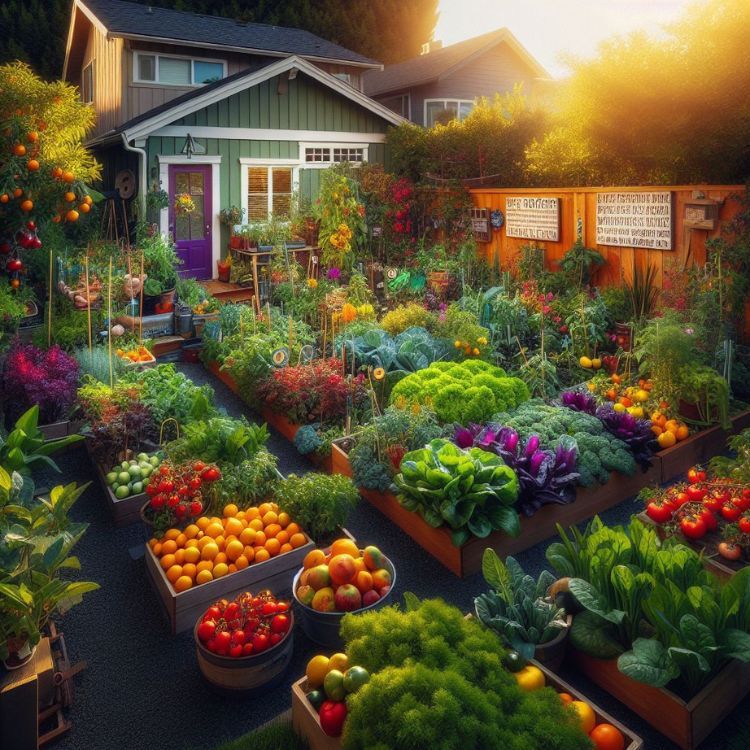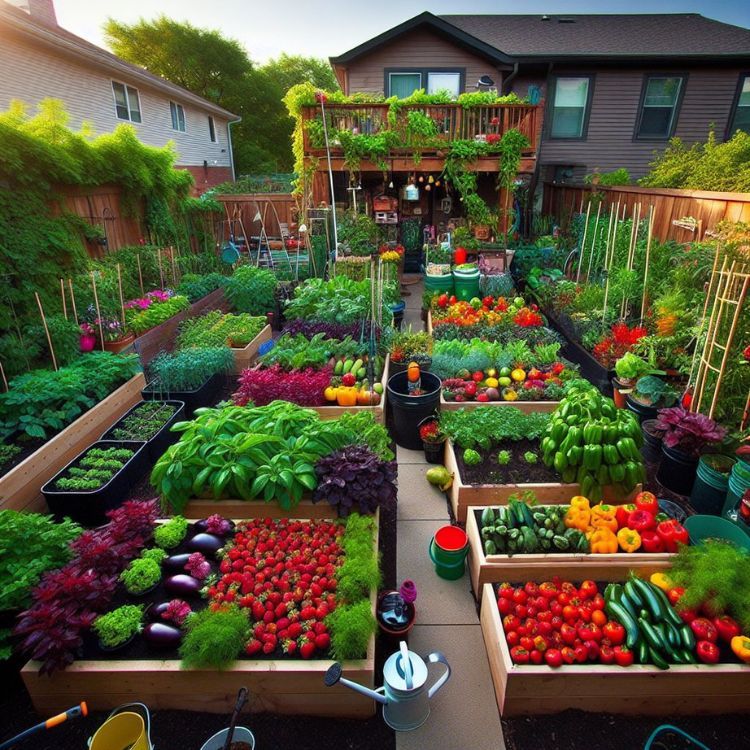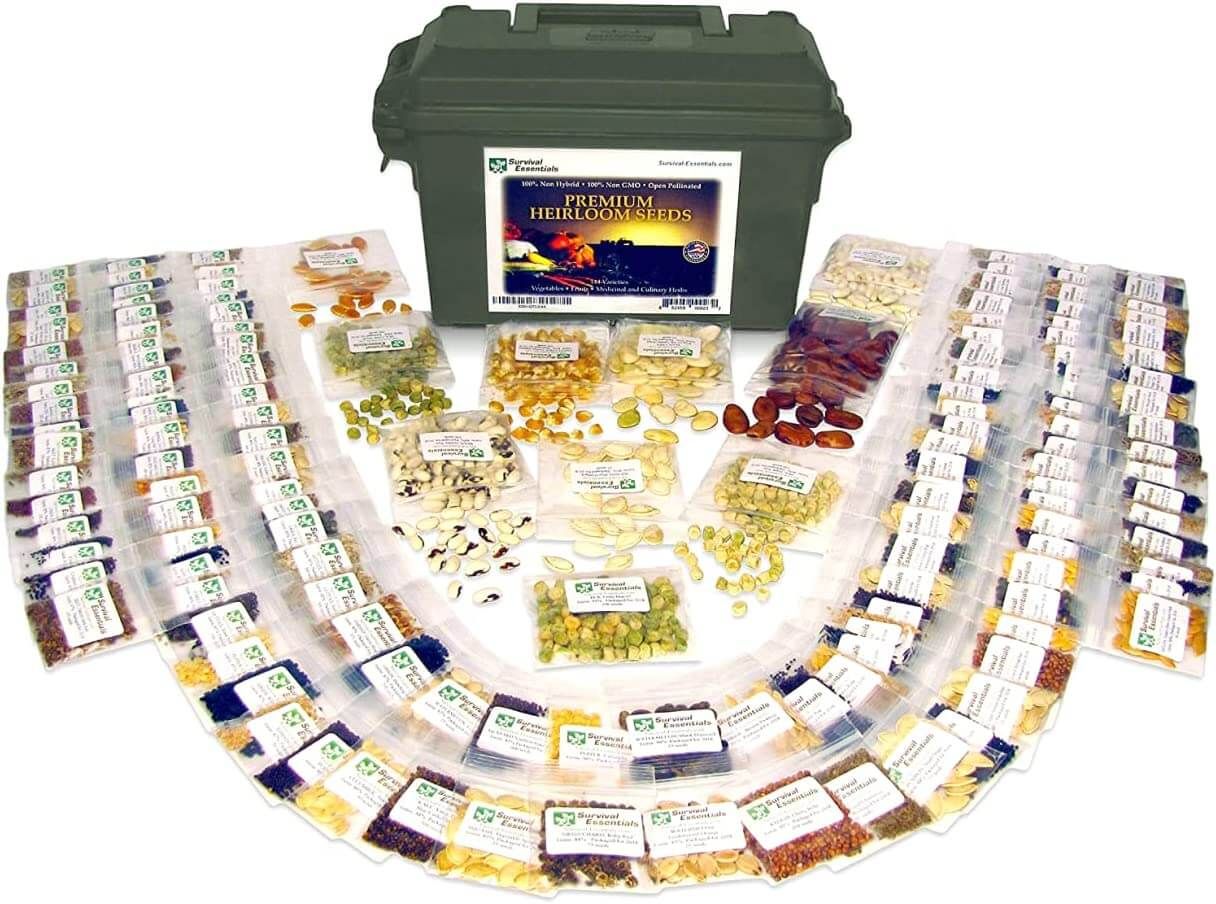
Article-at-a-Glance
Discover how to create a survival garden that’s as vibrant as it is nutritious with a rainbow of fruits and vegetables.
Learn the benefits of including colorful crops in your garden, such as enhanced nutritional content and natural disease resistance.
Get tips on selecting the best varieties for a diverse and eye-catching garden display.
Understand the importance of soil preparation and companion planting for healthy, bountiful yields.
Find out why Survival Essentials is a top choice for sourcing high-quality, nutritionally dense seeds for your garden.
Color Your Plate with Survival Garden Crops
When you think of a survival garden, you might envision rows of leafy greens and hearty vegetables. But let’s add a splash of color to that image. A survival garden can be a tapestry of hues, each color not just pleasing to the eye but packed with essential nutrients. Imagine plucking a bright red tomato, a deep purple eggplant, or a sunny yellow squash from your very own backyard. That’s the beauty of a rainbow harvest.
Maximize Nutrients with Every Hue
Each color in a fruit or vegetable signals a different set of nutrients and antioxidants. Red produce like tomatoes and strawberries are rich in lycopene, while the anthocyanins in blueberries and purple cabbage help protect your cells. Eating a variety of colors isn’t just fun—it’s a pathway to better health. That’s why I encourage you to think beyond green when planning your garden.
Year-Round Harvest Strategies
To ensure a continuous supply of fresh produce, it’s crucial to plan your garden with the seasons in mind. This means selecting crops that can be harvested at different times of the year. Some vegetables, like kale and carrots, can even withstand frost, giving you fresh produce well into the cooler months. By staggering your planting, you can enjoy a rainbow of flavors all year long.
Building Blocks of a Vibrant Survival Garden
Starting a survival garden may seem daunting, but it’s quite straightforward once you understand the basics. It’s all about choosing the right crops, preparing the soil, and caring for your plants. Let’s dig into these building blocks to help you grow a garden that’s as resilient as it is radiant.
Selecting Rainbow Varieties
Choosing the right varieties is the first step towards a colorful harvest. Look for seeds that are not only colorful but also adapted to your local climate. For inspiration on vibrant options to consider, check out this guide on Harvesting the Rainbow in your garden.
Red: Tomatoes, bell peppers, radishes
Orange: Carrots, pumpkins, sweet potatoes
Yellow: Summer squash, corn, yellow beets
Green: Lettuce, broccoli, zucchini
Blue/Purple: Eggplant, blueberries, blackberries
White: Cauliflower, garlic, onions
Remember, diversity is key. The more varieties you plant, the more resilient your garden will be to pests and diseases.
Designing Layout for Visual Appeal and Efficiency
Designing your garden layout is like painting a canvas. You want to create a balance of colors and textures that’s visually appealing and maximizes your space. Arrange your plants so that taller crops don’t shade out the smaller ones. Use trellises for vining plants like cucumbers and beans to save space and add vertical interest. The layout should not only look good but also make it easy for you to tend to your plants.
Nurturing Your Colorful Edibles

Gardening is more than just planting seeds and watching them grow; it’s about nurturing your plants to produce the best possible harvest. Caring for a variety of colorful edibles requires attention to detail, but the reward is a bountiful, vibrant garden that can support your family’s nutritional needs in tough times.
Organic Pest Control Methods
Pests can be a real threat to your survival garden. To keep your colorful crops safe, organic pest control is the way to go. You can use neem oil, a natural pesticide, to deter pests without harming beneficial insects like bees. Another method is to plant marigolds among your vegetables. Their strong scent repels many garden pests, and they add a beautiful splash of orange and yellow to your garden’s palette.
Companion planting is another effective strategy. For example, planting basil near tomatoes can help ward off flies and mosquitoes, while garlic planted near roses can deter aphids. Always keep an eye out for signs of infestation and tackle problems early to prevent them from spreading.
Pruning and Care for Optimal Color
Pruning isn’t just for aesthetic; it encourages your plants to thrive. By removing dead or overgrown branches, you allow more sunlight and air to reach the healthy parts of the plant, which can lead to more vibrant fruits and vegetables.
For example, tomato plants benefit greatly from pruning. By removing the lower leaves, you reduce the risk of soil-borne diseases and encourage the plant to put more energy into producing fruit. Similarly, pinching off the tips of pepper plants can lead to bushier growth and more peppers.
Don’t forget about regular feeding. A balanced organic fertilizer can provide your plants with the nutrients they need to produce the colorful, nutrient-rich produce you’re aiming for. Just follow the instructions carefully to avoid over-fertilization, which can be just as harmful as not fertilizing at all.
Harvest Time: From Garden to Table
After all your hard work, harvest time is incredibly rewarding. But timing is everything. Picking your fruits and vegetables at the right moment ensures the best flavor and nutritional content. Plus, a successful harvest sets the stage for your next planting season.
When and How to Pick Your Produce
Each type of fruit and vegetable has its own signs of ripeness. Tomatoes, for instance, should be firm and fully colored. Leafy greens, on the other hand, are best when they’re young and tender, before they start to toughen up and taste bitter. Here’s a quick guide:
Tomatoes: Deep, even color and slightly soft to the touch.
Peppers: Firm, glossy skin and a crisp snap when you bend the stem.
Leafy Greens: Harvest in the morning when leaves are most hydrated.
Root Vegetables: Check the top of the root for size; don’t let them get too large or they’ll lose flavor.
Most importantly, use the right tools for the job. Sharp scissors or pruners can make a clean cut without damaging the plant. And remember to handle your produce gently to prevent bruising.
For example, when harvesting leafy greens, cut leaves from the outside of the plant first. This allows the inner leaves to continue growing and provides a longer harvest period.
Preserving the Rainbow: Canning and Drying
Your garden’s bounty doesn’t have to be fleeting. By preserving your harvest, you can enjoy the fruits of your labor throughout the year. Canning is a great way to preserve tomatoes, cucumbers, and beans, while drying is perfect for herbs and some fruits like apples and berries.
Creative Cooking with Colorful Crops
Now comes the fun part—turning your harvest into delicious, nutritious meals. A rainbow garden gives you an array of flavors to play with. Whip up a fresh salad with red cherry tomatoes, orange carrots, yellow bell peppers, and green lettuce. Or roast a medley of purple potatoes, white garlic, and red onions for a side dish that’s as pleasing to the palate as it is to the eyes.
Why Choose Survival Essentials

With so many seed suppliers out there, why pick Survival Essentials for your survival garden needs? It’s simple: quality, variety, and reliability. Our seeds are selected for their nutritional density and adaptability to various climates, ensuring that your garden can withstand whatever comes its way.
Nutritionally Dense Seeds
Our seeds are not just colorful; they’re packed with vitamins and minerals to keep your family healthy. We’ve carefully curated our selection to include the most nutrient-dense varieties available, so every meal from your garden is a step towards better health.
Durable Seeds for Long-Term Planning
Survival gardening is about preparedness, and our seeds are chosen for their long-term viability. Whether you’re planting now or planning for future seasons, you can trust that our seeds will be ready when you are.
Visit Survival Essentials for Your Garden Needs
Ready to start your survival garden? Visit Survival Essentials to find the perfect selection of colorful, nutritious seeds. We’re here to help you grow a garden that’s as robust as it is radiant.
Discover how to create a survival garden that’s as vibrant as it is nutritious with a rainbow of fruits and vegetables.
Learn the benefits of including colorful crops in your garden, such as enhanced nutritional content and natural disease resistance.
Get tips on selecting the best varieties for a diverse and eye-catching garden display.
Understand the importance of soil preparation and companion planting for healthy, bountiful yields.
Find out why Survival Essentials is a top choice for sourcing high-quality, nutritionally dense seeds for your garden.
With so many seed suppliers out there, why pick Survival Essentials for your survival garden needs? It’s simple: quality, variety, and reliability. Our seeds are selected for their nutritional density and adaptability to various climates, ensuring that your garden can withstand whatever comes its way.
Our seeds are not just colorful; they’re packed with vitamins and minerals to keep your family healthy. We’ve carefully curated our selection to include the most nutrient-dense varieties available, so every meal from your garden is a step towards better health.
Nutritionally Dense Seeds
Our seeds are not just colorful; they’re packed with vitamins and minerals to keep your family healthy. We’ve carefully curated our selection to include the most nutrient-dense varieties available, so every meal from your garden is a step towards better health.
Durable Seeds for Long-Term Planning
Survival gardening is about preparedness, and our seeds are chosen for their long-term viability. Whether you’re planting now or planning for future seasons, you can trust that our seeds will be ready when you are.
Visit Survival Essentials for Your Garden Needs
Ready to start your survival garden? Visit Survival Essentials to find the perfect selection of colorful, nutritious seeds. We’re here to help you grow a garden that’s as robust as it is radiant. For inspiration on creating a vibrant garden, check out Harvesting the Rainbow and start planning your colorful array of fruits and vegetables today.
Frequently Asked Questions
As you embark on your gardening journey, you may have questions. Below are answers to some common queries that can help you get started with confidence.
What Makes a Garden a ‘Survival’ Garden?
A survival garden is designed to be self-sustaining, providing a reliable source of food in case of emergencies. It’s planned with resilience in mind, featuring crops that are hardy, nutrient-rich, and capable of growing in various conditions. The goal is to have a continuous supply of food that can support you and your family, regardless of what’s happening in the world around you.
Can I Grow Colorful Produce in Any Climate?
Yes, you can grow colorful produce in nearly any climate! The key is selecting the right varieties for your specific environment. Some plants thrive in cooler temperatures, while others need more sun and warmth. With the right choices, you can have a vibrant garden full of a variety of hues, no matter where you live.
How Do I Save Seeds from My Rainbow Harvest?
Saving seeds from your harvest is a smart way to ensure you have a continuous supply of your favorite crops. For most fruits and vegetables, wait until the produce is fully ripe, then remove the seeds and let them dry completely. Store them in a cool, dry place, and they’ll be ready for your next planting season.
What Are the Best Crops for Year-Round Color and Nutrition?
To maintain a colorful and nutritious garden year-round, focus on crops that can be harvested in different seasons. For example, leafy greens can be grown in cooler months, while tomatoes and peppers thrive in the heat. Root vegetables like carrots and beets store well and can provide nutrition even when not in season.
It’s also wise to consider perennials like berries and asparagus, which come back year after year, providing both color and nutrients with minimal replanting effort.
How Do I Get Started with My Own Survival Garden?
Starting your own survival garden begins with planning. Choose a sunny spot, decide on the size of your garden, and select crops that will thrive in your area. Prepare your soil by adding compost or organic matter, and then plant your seeds or seedlings. Remember to water, weed, and care for your plants as they grow. And, most importantly, enjoy the process of nurturing your garden and the harvest it provides.
For a head start, consider Survival Essentials for high-quality heirloom seeds that will bring color, nutrition, and security to your garden.







Leave a Reply